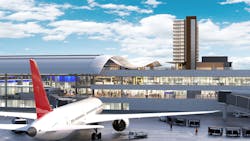A smart, connected airport can help travelers and staff enjoy a safer, more comfortable, enjoyable and efficient experience. But how is that accomplished? By integrating building, business, IT, and airport specialty systems, airports can create a safe, productive and responsive environment and improve overall efficiency.
For example, an optimized and integrated infrastructure streamlines communications and workflow. It’s an investment that contributes to future outcomes, offering a safe and secure environment, value-added services for passengers, and provides new business models for airlines, airport operators and retailers.
To promote the safety of staff and passengers, a connected, integrated airport provides early warnings, location-specific responses, increased visibility, real-time situational awareness, improved check-in and gate processing. To make airports more secure, integrated airports can improve intelligence, gain an integrated view from perimeter to passenger to assist in detecting threats faster, respond swiftly and mitigate associated impact of threats.
How to get started
To support the complex and flexible requirements of a multifaceted facility like an airport, it’s important to take a facility-wide view of the environment, rather than focus on single-point solutions targeted at meeting unique operational needs. With any new construction or technology retrofit project, the planning stage is the most important. Initial planning conversations should be focused on identifying desired outcomes, with the end goal of integrating the right technologies to deliver them. This requires that airport key stakeholders, their technology, design and construction partners step back and take a holistic view of the airport first.
For example, one airport saw a need to improve passenger traffic flow and prime the airport for future growth. For them, this meant lobby renovations, infrastructure and security improvements, new business space, concessions, restroom facilities and concourse circulation. With those objectives in mind, they were then ready to take the next step, and think about the necessary technologies and budget required to achieve their goals. These improvements required the integration of networked lighting controls, communications, access control and video management systems, fire detection and alarm systems, electronic visual information display systems and more.
Integrated airport success story
Another example is Nashville International Airport (BNA), which is undergoing a five-year, multi-faceted expansion known as BNA Vision. A major component of BNA Vision, and key to the expansion, is the revival and expansion of the airport’s Concourse D and enlarging the Ticketing Lobby and Baggage Claim. When it is complete in 2020, the Concourse D project will be a major step forward in BNA’s comprehensive plan to accommodate a continued increase in travelers, enhance overall traveler experience and highlight the look and feel for which the city is so well-known.
This requires a solution that addresses its long-term needs as well as propels forward its reputation as a world-class airport. Integral to determining the necessary technology updates required to achieve BNA’s objectives was an early engagement design-assist process with key airport stakeholders and its design and construction teams. That early planning phase, along with a Technology Contracting process for delivery of the integrated technology, will be crucial for achieving the desired outcomes. The Technology Contracting methodology will help the airport maximize the efficiency of technology selection, integration, and optimization. More importantly, it provides a single source of accountability throughout the process, which can help reduce costly miscommunications and construction delays during the project by providing expertise on the optimal technologies to purchase and install to maximize the value of the project. This outcome-driven approach to building optimization ultimately focuses on the airport’s unique needs and goals, creating a more efficient path toward achieving the high-performing, customized, truly intelligent airport they desire.
Today, it’s more critical than ever that airport facilities operate at the highest levels of efficiency, reliability and safety. Working with a technology partner experienced in the integration of airport systems to produce desired traveler and staff outcomes is among the best practices employed in the creation of a smart, connected airport.
Jim Nannini Joined Johnson Controls in 2005 as the Vice President of Building Wide Systems Integration. He has worked in the information technology services field for the past 30 years and has years of information technology services and software leadership experience in the areas of sales, engineering, marketing, operations, and general management, as well as experience with emerging market businesses.







